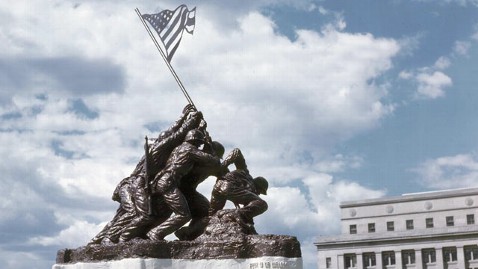Auction to Feature Iconic World War II Statue

(Image Credit: Courtesy Rodney Hilton Brown/AP Photo)
Looking to own an iconic piece of American military history? You're in luck.
A statue of the famed photograph of five Marines and one Navy corpsman raising the stars and stripes over Mt. Suribachi in Iwo Jima will be auctioned off at the end of the month by Rodney Hilton Brown, a collector of American war artifacts and a military historian.
The piece Brown plans to sell is the smaller forerunner to the 32-foot-tall Marine Corps War Memorial in Arlington, Va. At 20 feet high with the flag - 12 feet, two inches without it - the statue weighs 10,000 lb, according to Anne Wilson of Bonhams New York, the auction house hosting the sale.
"There's nothing like this," Wilson said of the statue, which will sell as part of a larger event called World War II: The Pacific Theater. "This is the original of this incredible symbol of history, of bravery of the Marine Corps and of World War II."
Bonhams describes the piece as "the original Iwo Jima monument, cast stone over a steel skeleton welded to a steel base, the monument finished with a bronzed lacquered layer."
Brown told ABC News he acquired the statue from its creator, Felix de Weldon, while working on a biography of the artist in 1990, in exchange for a violin, a sword and an amount of cash the two agreed to keep secret.
De Waldon also designed the Equestrian of Simon Bolivar Statue on Virginia Ave. in Washington, D.C.
Brown's website, a virtual museum devoted to the vestiges of war, shows his lifelong fascination with the country's ferocity in battle. He said he began collecting artifacts as a child of 10 or 11 years, going door-to-door to ask his neighbors for swords and guns from past U.S. wars.
When asked if collecting these materials was a passion of his, Brown said, "It's beyond that."
What then would make Brown want to sell such an iconic piece of his life's devotion?
"I'm 70 years old. I don't have an air craft carrier. It doesn't fit in my living room, and it's time to pass the torch to a younger generation," Brown said.
From 1995 until 2007, the statue made its home on display on the aircraft carrier Intrepid at the Intrepid Sea, Air and Space Museum in New York City.
But the museum asked Brown to take it back after undergoing renovations in 2007, The New York Times reported.
De Weldon sculpted the statue over the course of three months in 1945, based on the Pulitzer Prize-winning picture by Associated Press photographer Joe Rosenthal. It originally stood on Constitution Avenue, outside what was then the Navy Department.
The image that inspired the Iwo Jima Memorial has been a controversial part of American journalism.
It depicts the second raising of the American flag over Mt. Suribachi, not the first, immortalizing one team of patriots while leaving another band of heroes to fade from collective memory.
Rosenthal missed the first shot; over the years some have questioned whether Rosenthal staged the second raising, to achieve an image that would resonate with Americans' desire for a visualization of victory over a faraway enemy. But the photographer himself went to his grave defending the image's veracity.
Brown called de Weldon's piece "a monument to courage and valor."
He plans to donate a portion of the proceeds from its sale to the Marine Corps - Law Enforcement Foundation, which gives scholarships to children of fallen Marines and law enforcement personnel.
The perfect buyer in Brown's eye would be someone who could keep the memorial in the U.S.
"An American museum or a guy in Texas with a 50-foot living room," Brown said. "I just hope it stays here in the United States."